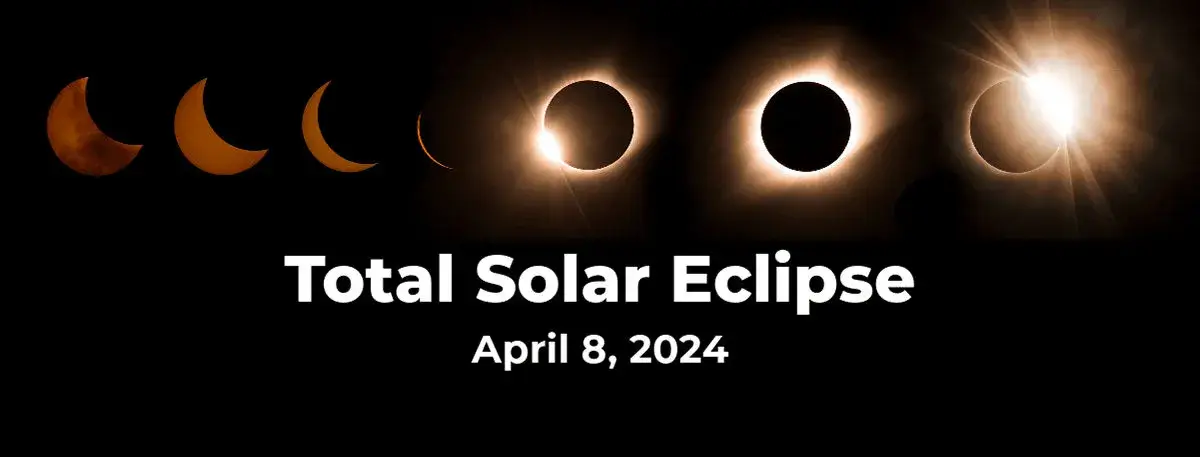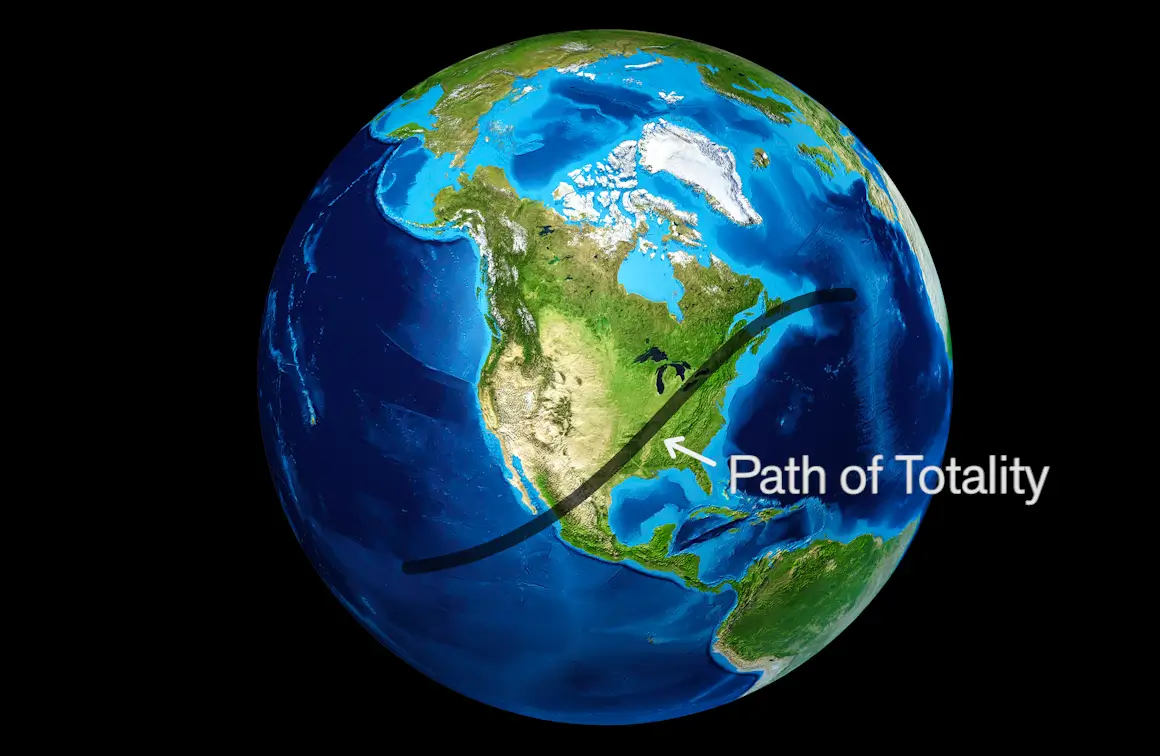In 2024, get ready to witness a breathtaking celestial event that will leave you in awe: the solar eclipse. This natural phenomenon, where the moon passes between the sun and Earth, promises to paint the sky with darkness and light like never before.
As the moon perfectly aligns with the sun, a rare spectacle unfolds, casting a shadow that slowly moves across the landscape. The air becomes cooler, birds go silent, and daylight appears to dim, stirring a sense of anticipation in all who lay eyes on this mesmerizing display.
The 2024 solar eclipse will be a sight to behold, captivating astronomers, nature enthusiasts, and curious onlookers alike. From the rugged mountains to the bustling cityscapes, people from all corners of the globe will witness the dance of light and darkness in a way that unites us in amazement.
So mark your calendars for 2024 and prepare yourself for an extraordinary experience. Witness the ethereal beauty of the solar eclipse, a fleeting moment that reminds us of the immense power and beauty of our universe.
Page Contents
- 1 What is a solar eclipse?
- 2 The science behind a solar eclipse
- 3 Historical significance of solar eclipses
- 4 The 2024 solar eclipse – date, time, and path of totality
- 5 Best places to view the 2024 solar eclipse
- 6 Safety tips for viewing a solar eclipse
- 7 Photography tips for capturing the solar eclipse
- 8 Cultural and spiritual beliefs surrounding solar eclipses
- 9 Embracing the beauty of darkness and light
- 10 Author
What is a solar eclipse?
A solar eclipse occurs when the moon passes between the sun and the Earth, casting a shadow on our planet. This alignment creates a temporary darkening of the sky, as the moon blocks the sun’s rays from reaching certain areas. There are three types of solar eclipses: total, partial, and annular.
During a total solar eclipse, the moon completely covers the sun, revealing the sun’s outer atmosphere, known as the corona. This phenomenon is considered one of nature’s most awe-inspiring events, with the sky turning dark and stars becoming visible in the middle of the day. The path of totality, where the total eclipse can be seen, is relatively narrow, making it a highly sought-after experience for many.
In contrast, a partial solar eclipse occurs when only a portion of the sun is obscured by the moon. This creates a dramatic crescent shape in the sky, as the sun appears partially hidden. While not as dramatic as a total eclipse, a partial eclipse still offers a unique and captivating view of the celestial dance.
Lastly, an annular eclipse happens when the moon is farthest from the Earth, resulting in a visible ring of sunlight around the moon’s silhouette. This creates a striking “ring of fire” effect as the moon covers most of the sun, leaving only a bright circle of light.
Regardless of the type, solar eclipses are a reminder of the intricate cosmic ballet that takes place in our solar system and the wonders that await us in the vastness of space.

The science behind a solar eclipse
Solar eclipses are a result of the precise alignment of the sun, moon, and Earth. The moon orbits our planet in an elliptical path, and when it reaches the point of alignment, a solar eclipse occurs.
The moon’s size and distance from Earth play a significant role in the phenomenon. The moon is approximately 400 times smaller than the sun, but it is also about 400 times closer to Earth. This unique coincidence allows the moon to appear the same size as the sun when viewed from our perspective.
During a solar eclipse, the moon’s shadow is cast onto Earth, creating a path of totality where the full eclipse can be seen. The shadow moves across the Earth’s surface at an average speed of around 1,700 kilometers per hour (1,056 miles per hour), providing observers with a limited window of opportunity to witness this extraordinary event.
Scientists and astronomers study solar eclipses to gather valuable data about the sun’s corona and its electromagnetic activity. These events offer a rare opportunity to observe the sun’s outer atmosphere, which is otherwise invisible due to the sun’s intense brightness. Through careful observation and analysis, researchers can deepen our understanding of the sun and its impact on our planet.
The science behind a solar eclipse is a testament to the intricate harmony of celestial bodies and the wonders of the universe that continue to captivate our imagination.
Historical significance of solar eclipses
Solar eclipses have held immense significance throughout history, often evoking fear, wonder, and reverence among ancient civilizations. Many early cultures believed that solar eclipses were a sign of impending doom or a disruption in the natural order of the world.
In ancient China, for example, solar eclipses were seen as a dragon devouring the sun. The people would bang drums and make loud noises to scare away the dragon and restore balance to the universe. Similarly, ancient Greeks believed that a solar eclipse was a sign of the gods’ anger, leading to panic and attempts to appease the deities.
Some ancient cultures also saw solar eclipses as a time of transformation and renewal. The Mayans, for instance, associated eclipses with the rebirth of the sun god and performed rituals to ensure the sun’s return. In Norse mythology, eclipses were believed to be caused by wolves chasing the sun and the moon, creating a temporary disruption in their celestial journey.
As our understanding of celestial mechanics grew, superstitions surrounding solar eclipses gave way to scientific curiosity. Today, solar eclipses continue to capture our collective fascination and serve as a reminder of the ancient link between humanity and the cosmos.
The 2024 solar eclipse – date, time, and path of totality
The eagerly anticipated 2024 solar eclipse will take place on April 8, captivating viewers across North America. This event will be a total solar eclipse, offering a rare opportunity for millions to witness the sky plunge into darkness during the path of totality.
The path of totality for the 2024 solar eclipse will stretch approximately 800 miles (1,287 kilometers) from Mexico to Canada, passing through several states including Texas, Arkansas, Missouri, Illinois, Indiana, Ohio, New York, and Vermont. Major cities such as Dallas, Indianapolis, Cleveland, and Buffalo will all experience the awe-inspiring darkness brought on by the eclipse.
The eclipse will begin in the late morning, with the moon’s shadow making its first contact with the sun around 10:15 a.m. local time. As the moon continues its journey, the sky will gradually darken, reaching totality around 2:30 p.m. local time in most areas along the path.
It’s important to note that the duration of totality will vary depending on the viewer’s location within the path. Some areas will experience a few minutes of complete darkness, while others may only see a partial eclipse. Planning ahead and finding the ideal viewing location will ensure a memorable and immersive experience.
The 2024 solar eclipse is undoubtedly an event that should not be missed, offering a chance to witness the awe-inspiring beauty of nature and the interconnectedness of our planet and the universe.
Best places to view the 2024 solar eclipse
With the 2024 solar eclipse set to captivate viewers across North America, finding the best viewing location is crucial for an unforgettable experience. While the path of totality stretches across several states and major cities, certain areas offer exceptional viewing conditions and unique landscapes to enhance the spectacle.
One of the prime locations to witness the 2024 solar eclipse is Carbondale, Illinois. Known as the “Eclipse Crossroads of America,” Carbondale has the distinction of being in the path of totality for both the 2017 and 2024 solar eclipses. The city boasts excellent weather conditions in April, and its southern location provides a higher chance of clear skies.
Another popular destination is Hot Springs, Arkansas. Nestled in the Ouachita Mountains, Hot Springs offers a stunning natural backdrop for the solar eclipse. The surrounding national parks and lakes provide ample opportunities for outdoor enthusiasts to combine their love for nature with the celestial event.
For those seeking an urban experience, Dallas, Texas, offers a vibrant cityscape combined with the thrill of witnessing a total solar eclipse. With its numerous viewing parties and events, Dallas provides a lively atmosphere for both locals and visitors to come together and celebrate this extraordinary event.
Other notable locations along the path of totality include Indianapolis, Indiana, with its rich cultural heritage and vibrant downtown; Cleveland, Ohio, known for its world-class museums and lakefront views; and Buffalo, New York, offering a unique blend of natural beauty and architectural marvels.
No matter where you choose to witness the 2024 solar eclipse, make sure to plan ahead and arrive early to secure the best viewing spot. Remember to check weather forecasts and local regulations to ensure a safe and enjoyable experience.
The 2024 solar eclipse presents an opportunity to explore new destinations, connect with fellow astronomy enthusiasts, and create lasting memories against the backdrop of this celestial wonder.

Safety tips for viewing a solar eclipse
While witnessing a solar eclipse is a captivating experience, it’s crucial to prioritize safety to protect your eyes and enjoy the event without any harm. Staring directly at the sun, even during an eclipse, can cause severe damage to your eyes, so it’s essential to take precautions.
Here are some safety tips to keep in mind when viewing a solar eclipse:
- Wear proper eye protection: Invest in solar eclipse glasses or handheld viewers that meet the internationally recognized safety standards for solar viewing. Regular sunglasses or homemade filters are not sufficient and can lead to eye damage.
- Check for damage: Before using solar eclipse glasses or viewers, inspect them for any scratches, holes, or damage. Even the tiniest defect can compromise eye safety.
- Follow instructions: Read and follow the instructions provided with the solar eclipse glasses or viewers carefully. Ensure they are worn correctly, covering your eyes completely and blocking out all direct sunlight.
- Beware of counterfeit products: Purchase solar eclipse glasses and viewers from reputable sources to avoid counterfeit or substandard products. Look for certifications and labels indicating compliance with safety standards.
- Supervise children: Keep a close eye on children during the eclipse and ensure they are wearing proper eye protection. Explain the importance of not looking directly at the sun without protective gear.
- Use indirect viewing methods: If you don’t have access to proper eye protection, consider alternative viewing methods such as pinhole projectors or solar filters on telescopes or cameras. These methods allow you to observe the eclipse indirectly without risking eye damage.
By following these safety guidelines, you can fully immerse yourself in the jp slot.
Photography tips for capturing the solar eclipse
Photographing a solar eclipse can be a rewarding and memorable experience, allowing you to preserve the celestial event for years to come. However, capturing the beauty and uniqueness of a solar eclipse requires careful planning and the right equipment. Here are some tips to help you capture stunning photographs of the 2024 solar eclipse:
- Use a solar filter: To protect your camera and lens from the intense brightness of the sun, use a solar filter specifically designed for photography. This will allow you to capture the eclipse without damaging your equipment.
- Set up in advance: Plan your photography setup well in advance to ensure you’re ready when the eclipse begins. Consider the location, angle, and composition you want to capture, and test your equipment beforehand to avoid any last-minute surprises.
- Use a tripod: Stability is crucial in capturing sharp photos of the solar eclipse. Use a sturdy tripod to keep your camera steady during the long exposures required for photographing the event.
- Experiment with exposure settings: Solar eclipses present unique lighting conditions, so be prepared to adjust your exposure settings accordingly. Start with a low ISO setting, a small aperture (high f-stop number), and a fast shutter speed. Make adjustments as needed to achieve the desired image.
- Include the surroundings: While the eclipse itself is the main attraction, including the surrounding landscape or cityscape can add depth and context to your photographs. Experiment with different compositions to capture the beauty of both the eclipse and its surroundings.
- Bracket your shots: The dynamic range of a solar eclipse can be challenging to capture in a single exposure. To ensure you capture all the details, consider bracketing your shots by taking multiple exposures at different settings. This will allow you to blend the images later and create a well-exposed final photograph.
Remember, photographing a solar eclipse requires patience, preparation, and a keen eye for detail. Don’t forget to take breaks from behind the camera to fully immerse yourself in the awe-inspiring experience of the eclipse.
Cultural and spiritual beliefs surrounding solar eclipses
Solar eclipses have long held cultural and spiritual significance for various civilizations throughout history. These unique celestial events have inspired myths, legends, and rituals that reflect the awe and wonder evoked by the darkening of the sun.
In ancient Greek mythology, solar eclipses were believed to be caused by the sun god Apollo temporarily leaving his chariot. Ancient Greeks would use the time of the eclipse to offer prayers and perform rituals in hopes of ensuring the sun’s return.
In Hindu mythology, solar eclipses are associated with the demon Rahu, who is said to swallow the sun or the moon during the eclipse. Hindu followers perform religious ceremonies and observe fasting during eclipses to protect themselves from any negative energy associated with Rahu.
In Native American cultures, solar eclipses were seen as a time for introspection and reflection. Some tribes believed that the sun and moon were engaged in a celestial battle during an eclipse, and people would gather to observe and pray for the sun’s eventual victory.
Across many cultures, solar eclipses have been regarded as moments of transformation and renewal. They symbolize the temporary merging of light and darkness, reminding us of the cyclical nature of life and the interconnectedness of all things in the universe.
While modern science has provided us with a deeper understanding of the mechanics behind solar eclipses, these cultural and spiritual beliefs continue to shape our perspectives and add a layer of wonder to these celestial events.
Embracing the beauty of darkness and light
The 2024 solar eclipse promises to be a celestial spectacle that will leave a lasting impression on all who witness it. As the moon’s shadow sweeps across the landscape, it offers a rare opportunity to experience the dance of darkness and light in the sky.
From the scientific marvel of cosmic alignment to the cultural and spiritual significance woven into ancient beliefs, solar eclipses have captivated humanity for centuries. They remind us of our place in the vast expanse of the universe and ignite a sense of wonder and curiosity that transcends borders and boundaries.
So mark your calendars and prepare yourself for the ethereal beauty of the 2024 solar eclipse. Whether you choose to travel to a prime viewing location or simply stepping outside your door, this eclipse offers a moment of connection—not only to the cosmos but also to each other. Gather with friends, family, or a crowd of enthusiastic observers; the collective experience of watching the day turn to night and back again is a powerful one. The 2024 solar eclipse is not just an astronomical event; it’s a reminder of the beauty and mysteries of the universe, inviting us to look up and marvel at the wonders above.












